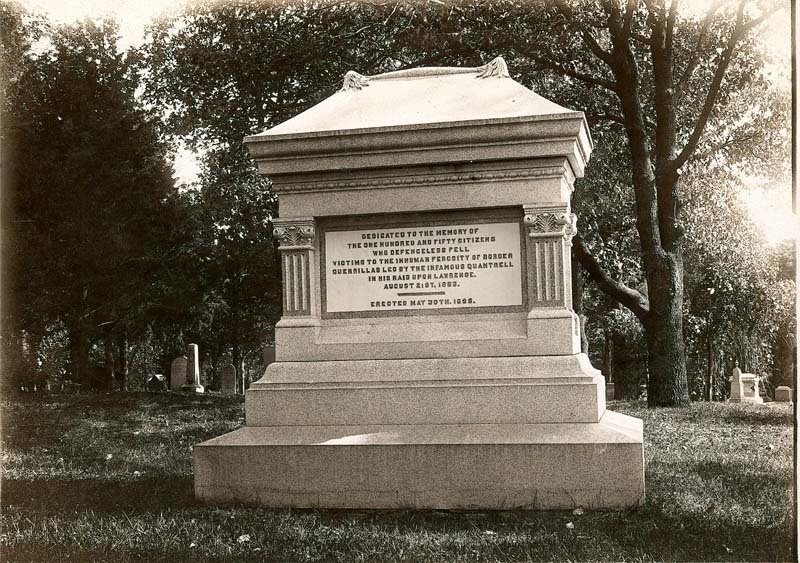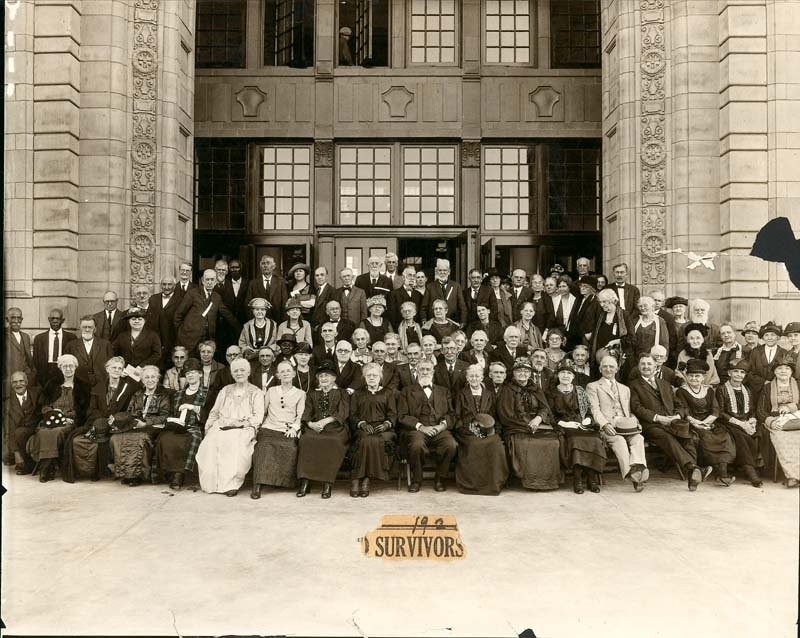Quantrill's Raid Memorial
Introduction
Text-to-speech Audio
Images
Monument Honoring Victims of Quantrill’s Raid, Oak Hill Cemetery, Photo courtesy of: kansashumanities.org

1925 Reunion of Quantrill's Raid Survivors, Photo courtesy of: kansashumanities.org

Backstory and Context
Text-to-speech Audio
William Quantrill (1837-1865) was a
schoolteacher and Confederate leader during the Civil War and headed the raid
on the Lawrence community. Quantrill had a troubled life, never seeming to
settle in one place. He was accused of killing a man and was set free due to
legal circumstances. He was also involved in a court dispute which took place
in Kansas and was banished from a community for stealing. Quantrill finally
seemed to find his place amongst a group of Missourian ruffians who protected
farms against the Jayhawkers. The Jayhawkers were based in Lawrence and were
associated with the free-state cause. By 1859, Quantrill had formed his
pro-slavery views. In 1861, Quantrill traveled to Texas where he learned Native
American fighting skills from the Cherokee Nations. He returned to Blue
Springs, Missouri and formed his own army of about ten men, known as
Quantrill's Raiders. These men were in no way associated with the Confederate
command. They were known as "bushwhackers" and kidnapped escaped
slaves for profit.
At the time, Lawrence, KS was the base of operations for incursions into
Missouri by the Jayhawkers who clashed with Quantrill's Raiders. The Jayhawkers
and other Union troops put civilian helpers of the Raiders in makeshift jails.
These civilians included several female relatives of the raiders. On August 14,
1863, the building housing the makeshift jail collapsed, killing the women.
Quantrill's men were furious and sought revenge. It is believed that this event
the raid on Lawrence. However, Quantrill may have been planning on attacking
Lawrence beforehand because this was not the first incident between the raiders
and the Jayhawkers.
The Lawrence Massacre of 1863 was perpetrated by Quantrill and his army of now
450 fighters on August 21, 1863. The raid began at Mount Oread and the raiders
had killed 150 men and boys by 9am, also destroying 200 buildings. The massacre
is the most deadly operation of Missourian Confederate guerillas. Four days
after the raid, in retaliation for the raid, Union General Ewing responded with
General Order No. 11 which required Missouri residents in border counties to
evacuate. This order caused suffering upon the people of Missouri, many of whom
had neither supported Quantrill or provided aid to his bushwhackers. 20,000
people were depopulated and their counties were burned and destroyed.
Commemorations to those who lost their lives in the Lawrence Massacre began on
August 21, 1891 and was organized by the Association of Survivors of
Quantrill's Massacre. The citizen's monument to the victims was unveiled in Oak
Hill Cemetery in Lawrence in 1895. Its inscription reads:
Dedicated to the memory of the one hundred and fifty citizens who defenseless fell victims to the in human ferocity of border guerillas led by the infamous Quantrill in his raid upon Lawrence. August 21st, 1862. Erected May 20th, 1895.
Sources
KHC Receives a Major Award. Kansas Humanities Council. November 20, 2014. Accessed October 08, 2017. http://kansashumanities.org/category/quantrills-raid/.
Wikipedia contributors. "William Quantrill." Wikipedia, The Free Encyclopedia. Wikipedia, The Free Encyclopedia, 30 Sep. 2017. Web.
